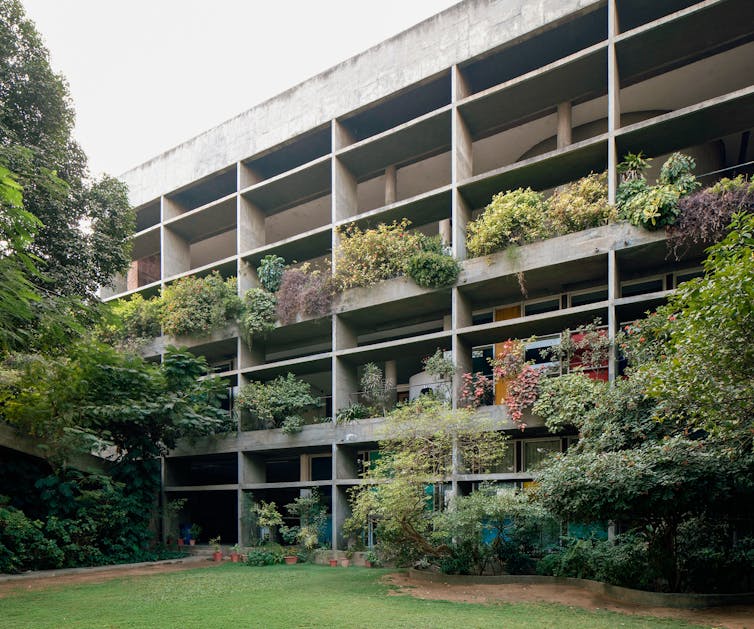To take the frictionless, scrolling pixels from Instagram and reproduce them in the physical world as a tactile, tablet-sized, small object of desire, is a curious concept. But the recently published book, Brutalist Plants, does just that, as its contents are derived from author Olivia Broome’s Instagram account.
Meta’s algorithms have previously delivered me other micro-niche topics such as @tiny.houses and @sexygutters, but I had not been aware of @brutalistplants before receiving this book. If you were, then you already know exactly what to expect – and you are probably the target audience. And you probably already know that this book is somehow about neither brutalist architecture, nor plants.
It is unusual for a book review to begin by discussing the publishers, but it seems particularly pertinent to Olivia Broome’s Brutalist Plants. A symbolic, if not a symbiotic, relationship seems to link the aims and values of publisher (Hoxton Mini Press) to the book’s objective and content. The half-title page states their office “overlooks a canal – a reminder of how much nature courses through this concrete jungle”. They hope “to remind readers of the richness of urban life”.
So, let’s deal with what this book is and what it is not. First, it is not about brutalist architecture, the baroque form of modernism that flowered briefly in Europe and America prior to the 1970s oil crisis. Nor its longer-lasting cousin, tropical modernism, where material mass is better suited to maintaining comfortable, internal environmental conditions.
A preface to the book by design reporter Alice Finney notes the name brutalism is associated with the French word for raw, via the expression béton brut. Coined around 1952 by the architect, Charles-Édouard Jeanneret (better known by his pen name, Le Corbusier), it describes leaving the construction process visible, as in the finish of his residential housing block, Unité d’Habitation in Marseille.
Fashions in architecture are, more or less, generational. So, the reappraisal of this once-reviled architecture is now virtually complete. Appreciation of brutalist architecture can be a form of nostalgia, perhaps representing the contrast between the apparent confidence of the era of “Swinging Sixties London” with our current age of anxiety and austerity.

Historically, brutalism also expressed a designer’s sensibility towards materials, structure and construction, whether of concrete, brick, or steel. That approach often resonates with today’s architecture students.
However, in this book, “brutalist” is used broadly to mean anything which is predominately constructed with exposed concrete. There are sea defences and water towers, abandoned infrastructure and military relics. The expressionist memorials of the former Yugoslavia and Daniel Libeskind’s angled Garden of Exile at the Jewish Museum in Berlin. Incongruously, the 2023 parametric-esque (parametricism is a contentious style of contemporary architecture) folded aluminium roof of the Hangzhou 926 Craftsman Museum by TJAD Original Design is also included.
Second, this book is not about plants. Most of the buildings and some of the other structures are named, but there is no attempt to identify any of the plants in case you are inspired to replicate the encircling jungle effect at home. This book is, however, all about images.
Ways of saying
In December 1979, Lucien Clergue was awarded a PhD by the University of Provence for a thesis entitled Langage des Sable (Language of the Sands).
Uniquely, at that time, the thesis consisted solely of a portfolio of photographs, forming a visual, rather than a textual, essay. It was examined by the philosopher Roland Barthes, who judged that a sequence of images could satisfy the requirement for a doctorate. He advocated that, like words, images can make an argument which is an “original contribution to knowledge”.
The art critic and novelist John Berger’s 1972 book, Ways of Seeing, included three “purely pictorial essays” that critiqued both the predominant narratives of art history and challenged how the history of art could be discussed. With these examples in mind, perhaps there more to Brutalist Plants than Instagram?
The preface suggests that it reflects contemporary architectural and environmental concerns with upgrading and reusing 20th-century buildings. It does not. The aesthetic has more affinity with the atmosphere found in ruinenlust (the obsession with ruins) posts shared in urban explorer forums than with a movement towards “creative reuse”, as prefigured by postmodern architect Ricardo Bofill’s La Fabrica, his home and office in a converted former cement works.

Broome says the photographs come from 41 different countries, but it is impossible to tell at a glance: all saturated greens against shades of “greige” (a combination of beige and grey), with bleached-out skies perhaps resulting from how digital cameras measure light and contrast. By contrast, Clergue’s close ups of rock formations and beaches evoke poet William Blake’s line: “to see a world in a grain of sand”.
The word “dystopia”, inevitably, is also evoked, but is meaningful only in the sense that these photographs are almost entirely devoid of human – or indeed any other fauna’s – presence. This vision seems to be of the world after humans have suddenly disappeared. Broome’s introduction urges us to appreciate these temporary palaces while we can. Perhaps then, the word “brutalist” does not apply to the buildings at all but to the plants – nature’s unsentimental survivors.
Brutalist Plants is perfectly formed, but ultimately an anachronism from Instagram-land before the introduction of “reels” (video content). It would be easy, therefore, to dismiss this as nothing more than the kind of picture book which would make a handsome Christmas stocking-filler, or that you might buy as a souvenir in the gift shop of the Barbican or the Hepworth gallery in Wakefield. But it is also not difficult to imagine that a curator with a point to make, or a stronger editorial position, could have given this book something radical and urgent to say, rather than succumbing to the seductive appeal to keep scrolling.

